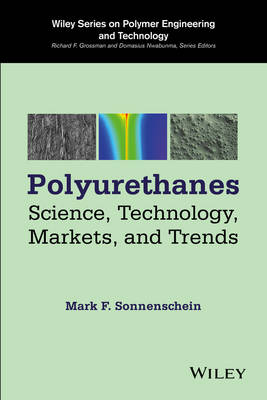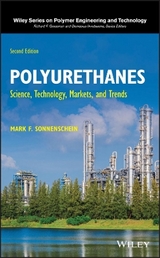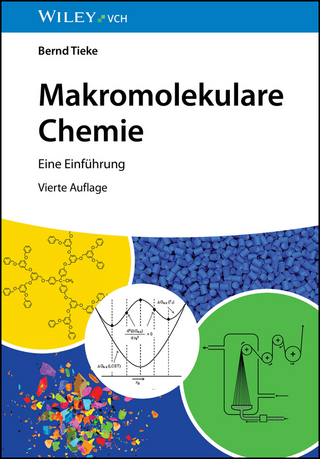
Polyurethanes
John Wiley & Sons Inc (Verlag)
978-1-118-73783-5 (ISBN)
- Titel erscheint in neuer Auflage
- Artikel merken
A complete overview of a key plastic One of the most versatile polymer materials, polyurethanes have a unique chemical nature that allows for shaping and molding to fit all sorts of consumer and industrial products seat cushions, carpets, insulation, coatings, and refrigerators to name a few. Despite its popular uses, polyurethane science has only relatively recently achieved appreciation for the richness of its expression as a polymer family. This book provides a thorough presentation of polyurethane science, technology markets and trend analysis based on recent patents. Although it does not provide ultimate detail (such as explicit information typically in patents), the book has a flow and continuity that allows readers to find all the background necessary to understand any other more detailed polyurethane information found elsewhere.
Anyone involved in the polymer and plastics industry will find this book a key resource with features that include: * An in-depth summary of the current state of polyurethane research and knowledge * Discussion of the applications, manufacture, and markets for polyurethanes * Analytical methods, reaction mechanisms, morphology, theoretical techniques, and the selection of chain extenders * Polyurethane flexible and rigid foams, elastomers, coatings, adhesives, and medical applications * In-depth coverage of governmental regulations, non-isocyanate/non-phosgene routes to polyurethane structure, and industrial routes to environmental, health, and safety risk mitigation
Mark Sonnenschein is a Fellow in the Material Sciences Division at the Dow Chemical Company. He holds 36 US and international patents and is the author of over 50 refereed journal articles and the chapter Polyurethanes in Wiley s Encyclopedia of Polymer Science and Technology.
Acknowledgments xi 1 Introduction 1 2 Polyurethane Building Blocks 10 2.1 Polyols, 11 2.1.1 Polyether Polyols, 12 2.1.2 Polyester Polyols, 28 2.1.3 Other Polyols, 42 2.1.4 Filled Polyols, 48 2.1.5 Seed Oil-Derived Polyols, 53 2.1.6 Prepolymers, 59 2.2 Isocyanates, 61 2.2.1 TDI, 63 2.2.2 Diphenylmethane Diisocyanates (MDI), 73 2.2.3 Aliphatic Isocyanates, 81 2.3 Chain Extenders, 89 3 Introduction to Polyurethane Chemistry 105 3.1 Introduction, 105 3.2 Mechanism and Catalysis of Urethane Formation, 107 3.3 Reactions of Isocyanates with Active Hydrogen Compounds, 113 3.3.1 Urea Formation, 116 3.3.2 Allophanate Formation, 117 3.3.3 Formation of Biurets, 119 3.3.4 Formation of Uretidione (isocyanate dimer), 119 3.3.5 Formation of Carbodiimide, 120 3.3.6 Formation of Uretonimine, 120 3.3.7 Formation of Amides, 123 4 Theoretical Concepts and Techniques in Polyurethane Science 127 4.1 Formation of Polyurethane Structure, 128 4.2 Properties of Polyurethanes, 137 4.2.1 Models and Calculations for Polymer Modulus, 138 4.2.2 Models for Elastomer Stress Strain Properties, 143 4.2.3 The Polyurethane Glass Transition Temperature, 152 5 Analytical Characterization of Polyurethanes 160 5.1 Analysis of Reagents for Making Polyurethanes, 161 5.1.1 Analysis of Polyols, 161 5.1.2 Analysis of Isocyanates, 166 5.2 Instrumental Analysis of Polyurethanes, 168 5.2.1 Microscopy, 169 5.2.2 IR Spectrometry, 176 5.2.3 X-Ray Analyses, 181 5.3 Mechanical Analysis, 188 5.3.1 Tensile, Tear, and Elongation Testing, 189 5.3.2 DMA, 195 5.4 N uclear Magnetic Spectroscopy, 199 6 Polyurethane Flexible Foams: Chemistry and Fabrication 207 6.1 Making Polyurethane Foams, 208 6.1.1 Slabstock Foams, 208 6.1.2 Molded Foams, 213 6.2 Foam Processes, 217 6.2.1 Surfactancy and Catalysis, 223 6.3 Flexible Foam Formulation and Structure Property Relationships, 228 6.3.1 Screening Tests, 228 6.3.2 Foam Formulation and Structure Property Relationships, 230 7 Polyurethane Flexible Foams: Manufacture, Applications, Markets, and Trends 235 7.1 Applications, 237 7.1.1 Furniture, 238 7.1.2 Mattresses and Bedding, 241 7.1.3 Transportation, 245 7.1.4 The Molded Foam Market, 246 7.2 Trends in Molded Foam Technology and Markets, 249 8 Polyurethane Rigid Foams: Manufacture, Applications, Markets, and Trends 255 8.1 Regional Market Dynamics, 255 8.2 Applications, 260 8.2.1 Construction Foams, 260 8.2.2 Rigid Construction Foam Market Segments, 272 8.2.3 Appliance Foams, 276 8.3 Blowing Agents and Insulation Fundamentals, 281 8.3.1 Blowing Agents, 281 8.3.2 Blowing Agent Phase-Out Schedule, 282 8.4 Insulation Fundamentals, 284 8.5 Trends in Rigid Foams Technology, 287 9 Polyurethane Elastomers: Manufacture, Applications, Markets, and Trends 294 9.1 Regional Market Dynamics, 295 9.2 Applications, 298 9.2.1 Footwear, 300 9.2.2 N onfootwear Elastomer Applications and Methods of Manufacture, 307 9.3 Trends in PU Elastomers, 328 10 Polyurethane Adhesives and Coatings: Manufacture, Applications, Markets, and Trends 336 10.1 Adhesive and Coating Industries: Similarities and Differences, 336 10.2 Adhesives, 339 10.2.1 Adhesive Formulations, 342 10.2.2 Trends in PU Adhesives, 350 10.3 Coatings, 353 10.3.1 PU Coating Formulations, 359 10.3.2 Trends in PU Coatings, 368 11 Special Topics: Medical Uses of Polyurethane 375 11.1 Markets and Participants, 375 11.2 Technology, 377 11.2.1 Catheters, 377 11.2.2 Wound Dressings, 380 11.2.3 Bioabsorbable Polyurethanes, 382 11.2.4 Hydrogels, 386 11.2.5 Gloves and Condoms, 387 12 Special Topic: Nonisocyanate Routes to Polyurethanes 392 12.1 Governmental Regulation of Isocyanates, 392 12.2 N onisocyanate Routes to Polyurethanes, 395 12.2.1 Reactions of Polycyclic Carbonates with Polyamines, 395 12.2.2 Direct Transformations of Amines to Urethanes, 400 12.2.3 Reactions of Polycarbamates, 403 12.2.4 Conversion of Hydroxamic Acids to Polyurethane, 404 12.2.5 Conversion of Hydroxylamines to Polyurethanes, 406 Index 409
| Reihe/Serie | Wiley Series on Polymer Engineering and Technology |
|---|---|
| Verlagsort | New York |
| Sprache | englisch |
| Maße | 167 x 245 mm |
| Gewicht | 840 g |
| Themenwelt | Naturwissenschaften ► Chemie ► Organische Chemie |
| Technik ► Maschinenbau | |
| ISBN-10 | 1-118-73783-0 / 1118737830 |
| ISBN-13 | 978-1-118-73783-5 / 9781118737835 |
| Zustand | Neuware |
| Informationen gemäß Produktsicherheitsverordnung (GPSR) | |
| Haben Sie eine Frage zum Produkt? |
aus dem Bereich



